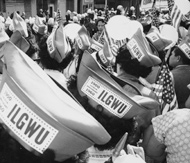

Highlights
The ILGWU Across the USA

Cleveland had a garment industry very early on, in fact, a Cloak Pressers’ Protective Union was formed in 1899, before the founding of the ILGWU. The early Cleveland Joint Board consisted of Cloak and Suit Tailors 26, Skirt and Dress Makers 27, Women Garment Makers 29, Ladies’ Garment Pressers 37, Ladies’ Garment Cutters 42, Sample and Ladies Tailors 94.
Strikes and low membership decimated the union in Cleveland from the strike of 1911 until the near closure of the Joint Board in 1916. The union had a difficult time gaining a position in the cloak and suit trade of the city. By the summer of 1917, membership in the Joint Board had risen significantly and in 1918, the union and the Joint Board submitted demands to the Cleveland Garment Manufacturers’ Association for a wage increase. After a strike, a Board of Referees was established to hear the controversy and render decisions. Relations between manufacturers and the Joint Board were strained, but in 1919, a collective agreement was signed by the manufacturers’ associations and the Cleveland Joint Board finally and firmly establishing the union in Cleveland after a decade of struggle. During this time, Charles Kreindler was the manager of the Joint Board.
In the 1920s, Cleveland was one of the only large cities that did not subscribe to a 44 hour week and week-work in the garment industry. Instead, the shops that manufactured medium priced garments utilized the section system, which required less skilled labor and posed a challenge for the Cleveland cloakmakers. An investigation by Cleveland Joint Board and the Cloak Manufacturers’’ Association established standards of production. In 1932, there was the Cleveland Cloak and Dress Strike. Hearings were conducted in 1938 before an impartial chairman to eliminate differences between the New York and Cleveland Cloak markets. By 1944, the Joint Board had established vacations with pay for all garment workers in the market, as well as adding a health plan with medical care, sick benefits and life insurance. The Joint Board was comprised of Locals 26, 27, 29, 37, 42, 44, 52, 207, 209, 211, 300, 358, and 368. The Joint Board and Ohio district were headed by Abraham Katovsky, who had been a business agent under Kreindler, and helmed the Cleveland Joint Board until his death in 1945. He was succeeded by Nathan Solomon as the new manager. Solomon had been serving as the secretary treasurer for many years. Approximately 1,000 knitgood workers in Cleveland were organized into four locals comprising the Cleveland Knitgoods Council. This Council was supervised by the head of the Cleveland Joint Board. During the early 1950s, Louis Friend managed the Joint Board, and Nicholas Kirtzman was the director of the Cleveland and Ohio-Kentucky Region.
A new headquarters for the Cleveland ILGWU Health Center and Ohio-Kentucky regional headquarters was dedicated in 1951. David Solomon manager of the Joint Board for many years after Friend, retired April 1956, and the organizer of the Joint Board, Julius Guralnik, took over duties as manager of the Cleveland Joint Board. From 1959 into the 1960s, with the Cleveland cloak market declining into insignificance, a shift in the Ohio-Kentucky Region took place from an emphasis on the cloak industry towards sportswear, knitgoods, and dresses. The Cleveland Knitgoods Council made significant membership gains. By 1962, Kirtzman became director and manager of the Joint Board, with Edward Milano the assistant director, and the steady decline in membership in Cleveland within the shrinking cloak and dress industry began to stabilize.
Kirtzman, an ILGWU vice-president and regional director since 1950, died in March 1963. Sam Janis, who was previously an assistant general manager of the Eastern Region, succeeded Kirtzman as the new Ohio-Kentucky Region director and was also elected manager of the Cleveland Joint Board. In 1968, Janis and the Joint Board were involved in the successful campaign for Carl Stokes election as mayor of Cleveland. Stokes was the first African American mayor of a large U.S. city, and Manager Janis was appointed to the mayor’s commission as a labor representative to study the welfare crisis in the city. During the 1970s, the Joint Board was involved in community and political activities, including submitting a proposal to ease procedures for voter registration.
In 1978, there was a realignment of the Ohio-Kentucky Region and all Ohio locals became part of the Northeast and Western Pennsylvania Department, renamed the Northeast, Western Pennsylvania and Ohio Department. Sam Janis retired in May 1978 and Al Gargiulo, who had been the assistant regional director, became the manager of the Cleveland Joint Board, as well as the Knitgoods Council and the Ohio District.
Kathryn Dowgiewicz


